Python共享单车数据分析
一、选题背景:
共享单车在2015年起开始在国内掀起热潮,目前已经逐渐成为了一种新的出行方式,日常生活中短途出行和代步出行,人们更加倾向于选择共享单车,这样既可以免去了等车的时间和花费,也更加的方便快捷、经济实惠,共享单车的出现为我们的生活带来了诸多便利。
二、数据说明:
kaggle的Bike Sharing Demand项目提供了美国某城市的共享单车2011年到2012年的数据集,该数据包括了租车日期,租车季节,租车气温,租车空气湿度等数据。
三、实施过程及代码:
导入库
1 import numpy as np 2 import pandas as pd 3 import calendar 4 import seaborn as sn 5 import matplotlib.pyplot as plt
查看数据大小
1 #查看数据大小 2 train=pd.read_csv("train.csv") 3 test=pd.read_csv("test.csv") 4 print('训练数据集:',train.shape,'测试数据集:',test.shape)

1 #查看数据情况 2 train.head()

1 #查看数据情况 2 test.head()

比较上述的两个表,我们可以知道test比train少了“casual”,“registered”,“count”三个字段
查看数据总体情况
1 #查看数据总体信息 2 print('训练集数据信息: ',train.info(),'测试集数据信息: ',test.info())
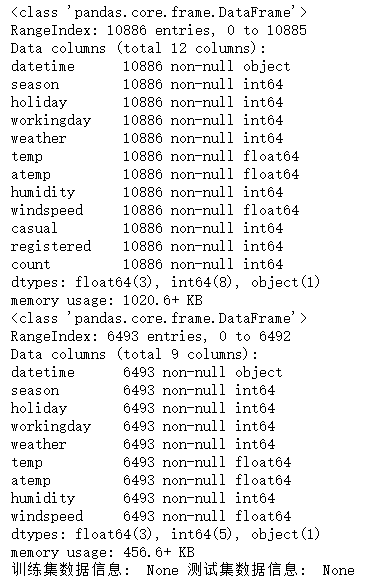
数据清洗
时间特征处理
1 #时间特征处理 2 #创建一个新的表框 3 periodDf=train[['datetime','season','holiday','workingday','count']] 4 #避免报错 5 periodDf.is_copy = None 6 #日期处理,把日期提取出来(用匿名函数分离出来) 7 periodDf['date']=periodDf['datetime'].apply(lambda x: x.split()[0]) 8 periodDf['time']=periodDf['datetime'].apply(lambda x: x.split()[1]) 9 periodDf['year']=periodDf['date'].apply(lambda x: x.split('-')[0]) 10 periodDf['month']=periodDf['date'].apply(lambda x: x.split('-')[1]) 11 periodDf['day']=periodDf['date'].apply(lambda x: x.split('-')[2]) 12 periodDf['hour']=periodDf['time'].apply(lambda x: x.split(':')[0]) 13 #星期 14 periodDf['weekday']=periodDf['datetime'].apply(lambda x: pd.to_datetime(x).weekday()) 15 #看看处理后的periodDf 16 periodDf.head()

绘图
1 #绘图 2 fig1=plt.figure(figsize=(16,4)) 3 ax1=plt.subplot(111) 4 df1=periodDf.groupby(['month','year']).sum().unstack()['count']#unstack(),将列索引变为行索引 5 df1.plot(kind='area',ax=ax1,alpha=0.6) 6 ax1.set_title('2011-2012 bikes sharing demand by month') 7 ax1.set_xlabel('Figure 1') 8 ax1.set_xticks(list(range(12))) 9 ax1.set_xticklabels(['Jan','Feb','Mar','Apr','May','June','July','Aug','Sep','Oct','Nov','DeC']) 10 ax1.set_xlim(0,11)

通过上图分析:我们可以看到2012年共享单车的租借数量比2011年是有提升的,一年中6-10月是租借的高峰期。
节假日和非节假日租车情况
1 #节假日和非节假日租车情况 2 fig2=plt.figure(figsize=(16,6)) 3 ax2=plt.subplot(111) 4 df2=periodDf[['count','holiday']] 5 df2.boxplot(by='holiday',ax=ax2) 6 ax2.set_title('2011-2012 bike sharing demand by holiday') 7 ax2.set_xlabel('Figure 2') 8 ax2.set_xticklabels(['Non holiday','holiday'],rotation='horizontal') 9 ax2.set_ylim(0,800)
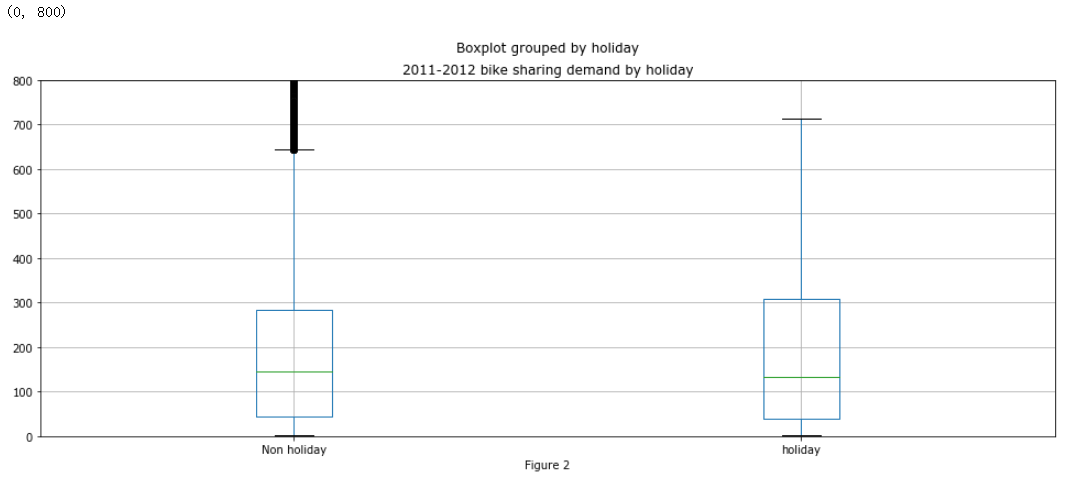
工作日和周末的租车情况
1 #工作日和周末的租车情况 2 fig3=plt.figure(figsize=(16,6)) 3 ax3=plt.subplot(111) 4 df3=periodDf[['count','weekday']] 5 df3.boxplot(by='weekday',ax=ax3) 6 ax3.set_title('2011-2012 bike sharing demand by weekday') 7 ax3.set_xlabel('Figure 3') 8 ax3.set_xticklabels(['Mon','Tue','Wed','Thu','Fri','Sat','Sun'], rotation='horizontal') 9 ax3.set_ylim(0,800)
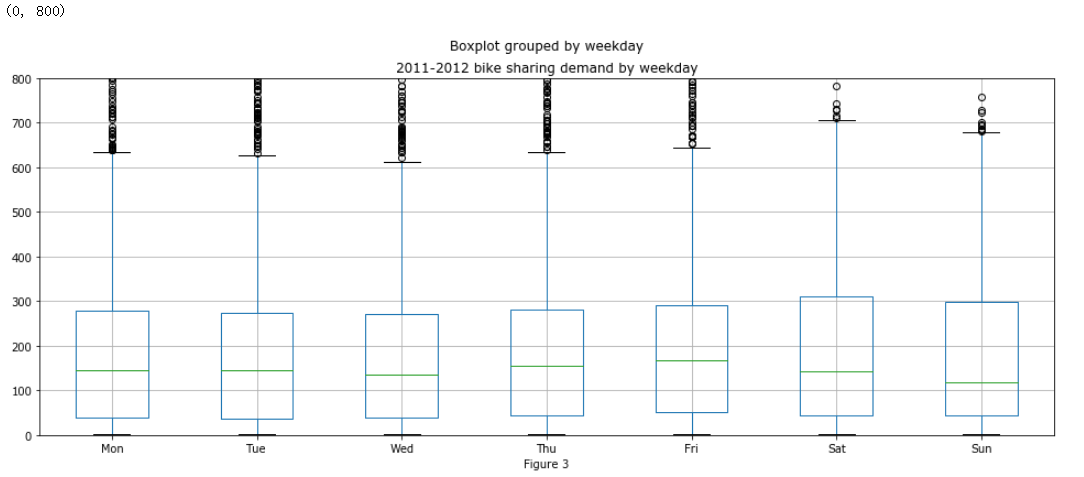
租车数量随季节变化趋势
1 #租车数量随季节变化趋势 2 fig5=plt.figure(figsize=(14,4)) 3 ax5=plt.subplot(111) 4 df51=periodDf.groupby(['hour','holiday']).mean().unstack()['count'].rename(columns={0:'Non holiday',1:'holiday'}) 5 df52=periodDf.groupby(['hour','workingday']).mean().unstack()['count'].rename(columns={0:'weekend',1:'workingday'}) 6 df51.plot(ax=ax5,style=':,') 7 df52.plot(ax=ax5,style='-o') 8 ax5.set_title('2011-2012 bike sharing demand by hours') 9 ax5.set_xlabel('figure 5') 10 ax5.set_xticks(list(range(24))) 11 ax5.set_xticklabels(list(range(24))) 12 ax5.set_xlim(0,23) 13 ax5.legend() 14 plt.show()
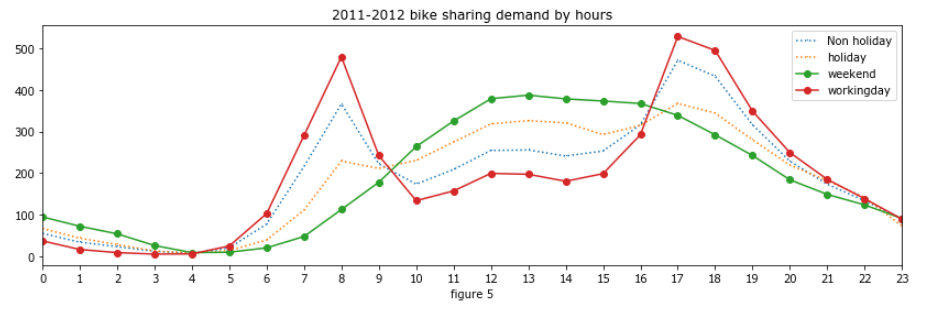
非时间特征处理
1 #天气、温度、湿度、风速信息统计 2 climateDf=train[['weather','temp','atemp','humidity','windspeed','count']] 3 climateDf=pd.concat([climateDf,periodDf['hour']],axis=1)
1 #查看天气和风速对租车数量的影响 2 fig,axes=plt.subplots(1,2,figsize=(20,6)) 3 ax6=plt.subplot(1,2,1) 4 df11=climateDf.groupby('weather').sum()['count'] 5 df12=climateDf.groupby('weather').mean()['count'] 6 df1=pd.concat([df11,df12],axis=1).reset_index() 7 df1.columns=['weather','sum','mean'] 8 df1['sum'].plot(kind='bar',width=0.4,ax=ax6,alpha=0.6,label='') 9 df1['mean'].plot(style='r-',alpha=0.6,ax=ax6,secondary_y=True,label='mean') 10 11 ax6.set_xlabel('weather') 12 ax6.set_xticks(df1.index) 13 ax6.set_xticklabels(['sunny&cloudy','Fog&overcast','light rain&light snow','bad weather'], rotation='horizontal') 14 ax6.set_ylabel('total') 15 ax6.right_ax.set_ylabel('mean') 16 ax6.set_title('2011-2012 bike sharing demand by weather') 17 ax7=plt.subplot(1,2,2) 18 19 df21=climateDf.groupby('windspeed').sum()['count'] 20 df22=climateDf.groupby('windspeed').mean()['count'] 21 df2=pd.concat([df21,df22],axis=1).reset_index() 22 df2.columns=['windspeed','sum','mean'] 23 df2['sum'].plot(kind='area',ax=ax7,alpha=0.7,color='orange',label='') 24 df2['mean'].plot(style='-',alpha=0.6,color='red',ax=ax7,secondary_y=True,label='mean') 25 ax7.set_xlabel('windspeed') 26 ax7.set_ylabel('total') 27 ax7.right_ax.set_ylabel('mean') 28 ax7.set_title('2011-2012 bike sharing demand by windspeed') 29 plt.show()

左图柱状图反应了不同天气下租车总数的变化,大雨大雪大雾这种恶劣天气最低。折现图反应了各种天气下平均租车数量,异常的是平均数量在恶劣天气下反而显著增加;
右图反应了随着风速变大,租车的总数量趋向于0,但平均租车数却最高。
1 train[train['weather']==4]

1 train[train['windspeed']>50]

通过查看原始数据发现,这种极端情况的数据仅为个例,所以造成了异常现象
湿度、温度对租车数量的影响
1 #查看湿度、温度对租车数量的影响 2 fig=plt.subplots(1,2,figsize=(20,8)) 3 4 ax1=plt.subplot(1,2,1) 5 df1=climateDf[['humidity','count']] 6 ax1.scatter(df1['humidity'],df1['count'],s=df1['count']/5, c=df1['count'],marker='.',alpha=0.6) 7 ax1.set_title('2011-2012 bike sharing demand by humidity') 8 ax1.set_xlabel('humidity') 9 ax1.set_ylabel('count') 10 11 ax2=plt.subplot(1,2,2) 12 df2=climateDf[['temp','count']] 13 ax2.scatter(df2['temp'],df2['count'],s=df1['count']/5, c=df1['count'],marker='.',alpha=0.6) 14 ax2.set_title('2011-2012 bike sharing demand by temperature') 15 ax2.set_xlabel('temperature') 16 ax2.set_ylabel('count') 17 plt.show()
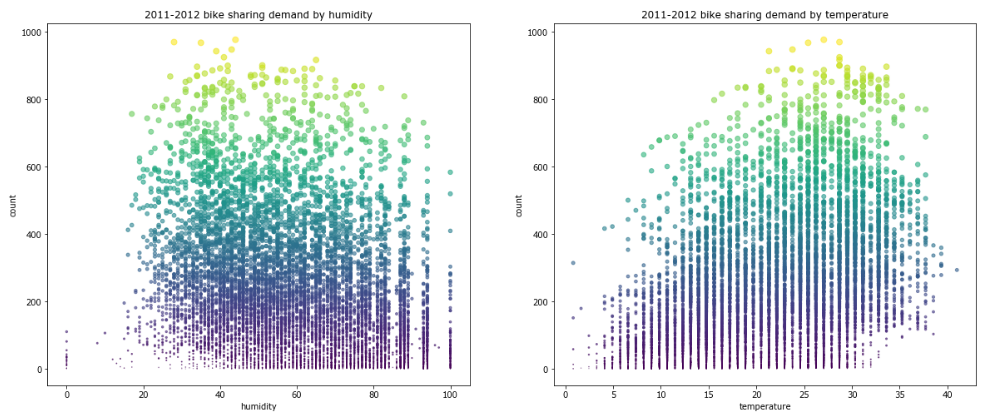
最适合的湿度为30-40附近,温度越高,租车数量减少,最适合的温度在25-30左右
租车数量和其它变量的相关性
1 #查看租车数量和其它变量的相关性 2 df=pd.concat([periodDf.iloc[:,-5:].astype(int),train.iloc[:,1:]],axis=1) 3 corrDf=df.corr() 4 mask=np.array(corrDf) 5 mask[np.tril_indices_from(mask)]=False 6 fig=plt.figure(figsize=(15,15)) 7 sn.heatmap(corrDf,mask=mask,annot=True,square=True) 8 plt.show()
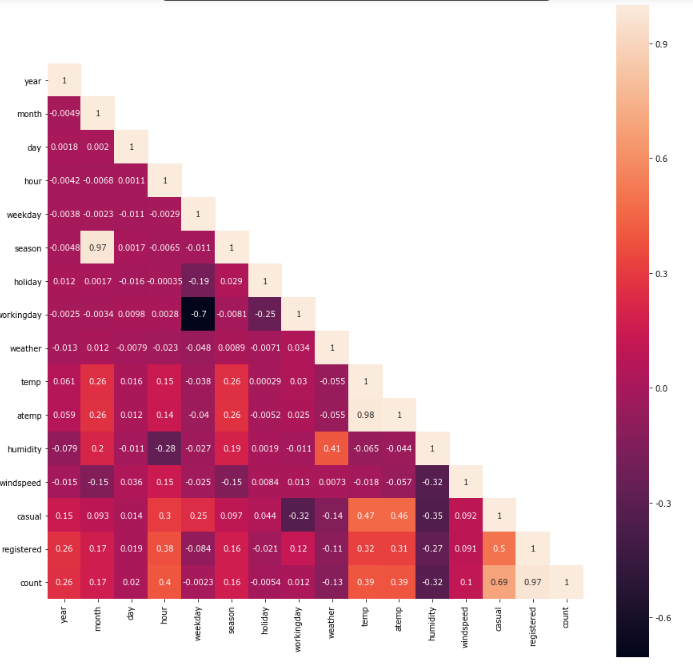
完整代码
1 import numpy as np 2 import pandas as pd 3 import calendar 4 import seaborn as sn 5 import matplotlib.pyplot as plt 6 7 #查看数据大小 8 train=pd.read_csv("train.csv") 9 test=pd.read_csv("test.csv") 10 print('训练数据集:',train.shape,'测试数据集:',test.shape) 11 12 #查看数据情况 13 train.head() 14 test.head() 15 16 #查看数据总体信息 17 print('训练集数据信息: ',train.info(),'测试集数据信息: ',test.info()) 18 19 20 #时间特征处理 21 #创建一个新的表框 22 periodDf=train[['datetime','season','holiday','workingday','count']] 23 #避免报错 24 periodDf.is_copy = None 25 #日期处理,把日期提取出来(用匿名函数分离出来) 26 periodDf['date']=periodDf['datetime'].apply(lambda x: x.split()[0]) 27 periodDf['time']=periodDf['datetime'].apply(lambda x: x.split()[1]) 28 periodDf['year']=periodDf['date'].apply(lambda x: x.split('-')[0]) 29 periodDf['month']=periodDf['date'].apply(lambda x: x.split('-')[1]) 30 periodDf['day']=periodDf['date'].apply(lambda x: x.split('-')[2]) 31 periodDf['hour']=periodDf['time'].apply(lambda x: x.split(':')[0]) 32 #星期 33 periodDf['weekday']=periodDf['datetime'].apply(lambda x: pd.to_datetime(x).weekday()) 34 #看看处理后的periodDf 35 periodDf.head() 36 37 38 #绘图 39 fig1=plt.figure(figsize=(16,4)) 40 ax1=plt.subplot(111) 41 df1=periodDf.groupby(['month','year']).sum().unstack()['count']#unstack(),将列索引变为行索引 42 df1.plot(kind='area',ax=ax1,alpha=0.6) 43 ax1.set_title('2011-2012 bikes sharing demand by month') 44 ax1.set_xlabel('Figure 1') 45 ax1.set_xticks(list(range(12))) 46 ax1.set_xticklabels(['Jan','Feb','Mar','Apr','May','June','July','Aug','Sep','Oct','Nov','DeC']) 47 ax1.set_xlim(0,11) 48 49 50 #节假日和非节假日租车情况 51 fig2=plt.figure(figsize=(16,6)) 52 ax2=plt.subplot(111) 53 df2=periodDf[['count','holiday']] 54 df2.boxplot(by='holiday',ax=ax2) 55 ax2.set_title('2011-2012 bike sharing demand by holiday') 56 ax2.set_xlabel('Figure 2') 57 ax2.set_xticklabels(['Non holiday','holiday'],rotation='horizontal') 58 ax2.set_ylim(0,800) 59 60 61 #工作日和周末的租车情况 62 fig3=plt.figure(figsize=(16,6)) 63 ax3=plt.subplot(111) 64 df3=periodDf[['count','weekday']] 65 df3.boxplot(by='weekday',ax=ax3) 66 ax3.set_title('2011-2012 bike sharing demand by weekday') 67 ax3.set_xlabel('Figure 3') 68 ax3.set_xticklabels(['Mon','Tue','Wed','Thu','Fri','Sat','Sun'], rotation='horizontal') 69 ax3.set_ylim(0,800) 70 fig4=plt.figure(figsize=(14,4)) 71 ax4=plt.subplot(111) 72 df4=periodDf.groupby(['hour', 'season']).mean().unstack()['count'] 73 df4.columns=['Spring','Summer','Fall','Winter'] 74 df4.plot(ax=ax4, style='--.') 75 ax4.set_title('2011-2012 bike sharing demand by hours') 76 ax4.set_xlabel('Figure 4') 77 ax4.set_xticks(list(range(24))) 78 ax4.set_xticklabels(list(range(24))) 79 ax4.set_xlim(0,23) 80 81 82 #租车数量随季节变化趋势 83 fig5=plt.figure(figsize=(14,4)) 84 ax5=plt.subplot(111) 85 df51=periodDf.groupby(['hour','holiday']).mean().unstack()['count'].rename(columns={0:'Non holiday',1:'holiday'}) 86 df52=periodDf.groupby(['hour','workingday']).mean().unstack()['count'].rename(columns={0:'weekend',1:'workingday'}) 87 df51.plot(ax=ax5,style=':,') 88 df52.plot(ax=ax5,style='-o') 89 ax5.set_title('2011-2012 bike sharing demand by hours') 90 ax5.set_xlabel('figure 5') 91 ax5.set_xticks(list(range(24))) 92 ax5.set_xticklabels(list(range(24))) 93 ax5.set_xlim(0,23) 94 ax5.legend() 95 plt.show() 96 97 98 #天气、温度、湿度、风速信息统计 99 climateDf=train[['weather','temp','atemp','humidity','windspeed','count']] 100 101 102 #查看天气和风速对租车数量的影响 103 fig,axes=plt.subplots(1,2,figsize=(20,6)) 104 ax6=plt.subplot(1,2,1) 105 df11=climateDf.groupby('weather').sum()['count'] 106 df12=climateDf.groupby('weather').mean()['count'] 107 df1=pd.concat([df11,df12],axis=1).reset_index() 108 df1.columns=['weather','sum','mean'] 109 df1['sum'].plot(kind='bar',width=0.4,ax=ax6,alpha=0.6,label='') 110 df1['mean'].plot(style='r-',alpha=0.6,ax=ax6,secondary_y=True,label='mean') 111 ax6.set_xlabel('weather') 112 ax6.set_xticks(df1.index) 113 ax6.set_xticklabels(['sunny&cloudy','Fog&overcast','light rain&light snow','bad weather'], rotation='horizontal') 114 ax6.set_ylabel('total') 115 ax6.right_ax.set_ylabel('mean') 116 ax6.set_title('2011-2012 bike sharing demand by weather') 117 ax7=plt.subplot(1,2,2) 118 df21=climateDf.groupby('windspeed').sum()['count'] 119 df22=climateDf.groupby('windspeed').mean()['count'] 120 df2=pd.concat([df21,df22],axis=1).reset_index() 121 df2.columns=['windspeed','sum','mean'] 122 df2['sum'].plot(kind='area',ax=ax7,alpha=0.7,color='orange',label='') 123 df2['mean'].plot(style='-',alpha=0.6,color='red',ax=ax7,secondary_y=True,label='mean') 124 ax7.set_xlabel('windspeed') 125 ax7.set_ylabel('total') 126 ax7.right_ax.set_ylabel('mean') 127 ax7.set_title('2011-2012 bike sharing demand by windspeed') 128 plt.show() 129 climateDf=pd.concat([climateDf,periodDf['hour']],axis=1) 130 train[train['weather']==4] 131 train[train['windspeed']>50] 132 133 134 #查看湿度、温度对租车数量的影响 135 fig=plt.subplots(1,2,figsize=(20,8)) 136 ax1=plt.subplot(1,2,1) 137 df1=climateDf[['humidity','count']] 138 ax1.scatter(df1['humidity'],df1['count'],s=df1['count']/5, c=df1['count'],marker='.',alpha=0.6) 139 ax1.set_title('2011-2012 bike sharing demand by humidity') 140 ax1.set_xlabel('humidity') 141 ax1.set_ylabel('count') 142 ax2=plt.subplot(1,2,2) 143 df2=climateDf[['temp','count']] 144 ax2.scatter(df2['temp'],df2['count'],s=df1['count']/5, c=df1['count'],marker='.',alpha=0.6) 145 ax2.set_title('2011-2012 bike sharing demand by temperature') 146 ax2.set_xlabel('temperature') 147 ax2.set_ylabel('count') 148 plt.show() 149 150 151 #查看租车数量和其它变量的相关性 152 df=pd.concat([periodDf.iloc[:,-5:].astype(int),train.iloc[:,1:]],axis=1) 153 corrDf=df.corr() 154 mask=np.array(corrDf) 155 mask[np.tril_indices_from(mask)]=False 156 fig=plt.figure(figsize=(15,15)) 157 sn.heatmap(corrDf,mask=mask,annot=True,square=True) 158 plt.show()
总结
经过上述的可视化分析,我们对共享单车租车数据有了大致的把握,对数据特征之间的关系有了初步的了解。季节、小时、月份、工作日非工作日、天气状况、温度、湿度、风速等特征对总体需求量有相关性。总的来说,效果还是蛮不错的,后面会再多加强这方面的知识。


